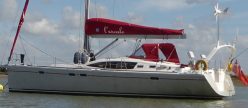Wednesday 5 – Tuesday 11 August
Unusually, we applied ourselves on Wednesday morning, perhaps a reflection of our lack of desire to explore Majorca any further, and at 0800, amidst a mini Armada of nine yachts, were away and bound for Menorca. The day began very still and calm of wind and water, as we motored steadily past spectacular cliffs that should have been rich in bird colonies. We spotted one hawk, and in the early afternoon, as we cleared the Cabo de Formentor light at the Northeast point of Majorca, Menorca was visible ahead in the haze. From the East, the view back towards Majorca is of two distinct islands of mountains, but there is a wide, fertile, low-lying plain between them, where much of the island’s fresh food is produced.
At 1600 Mate spotted a small mound drifting towards us in the oily water. Closer examination revealed it as a sea turtle, about dinner plate-sized in diameter, paddling gently by. Her yell of delight to alert Skipper appeared to startle the little fellow, whose head seemed to jerk up to glare a beady eye at her, but our steady five knots’ motoring was fast enough that he was soon gone in our wake. Our first sighting of these delightful creatures in the wild.
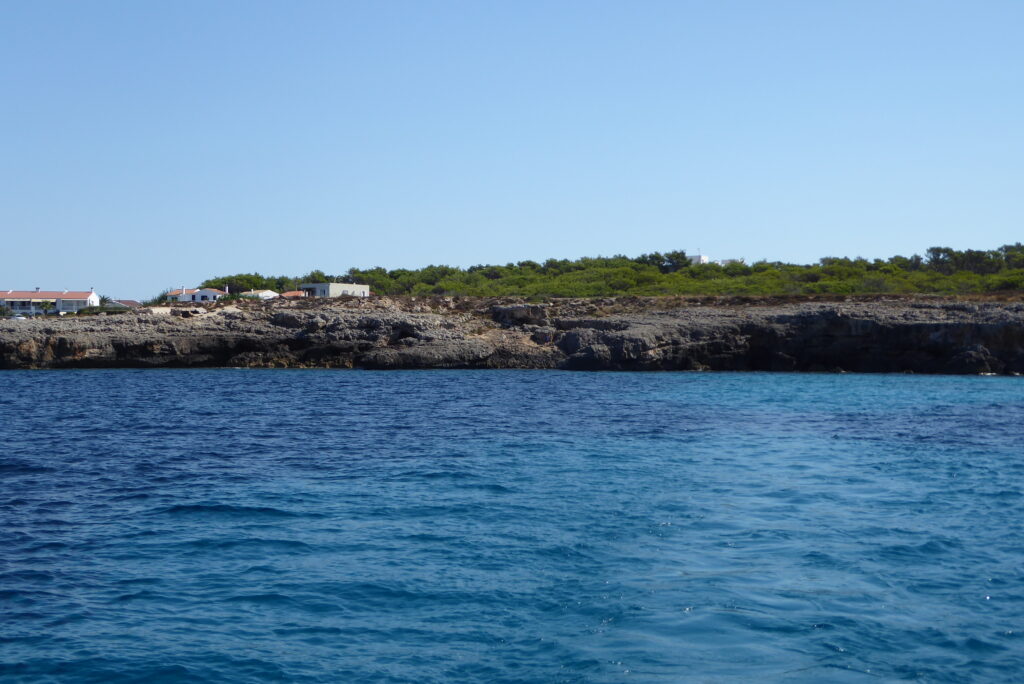
Western Menorca coastline
Exactly twelve hours after departure, with 59 Miles under our keel, we were anchored in a pleasant open bay on the West coast of Menorca, near Cala Blanca, having dismissed the anchorage at Ciutadella as too full already. We found a lovely patch of clean sand all to ourselves, to the edge of the larger area already chosen by a number of varying vessels.
Whilst at sea, an e-mail came through from our German friends first met in Gibraltar, who had spent lockdown in Portimão, on the Portuguese Algarve. They had made a sudden decision to head for the Balearics, and had hoped to surprise us in Port Sóller, only to see we’d moved on ahead of them. We agreed to wait for them, somewhere on the North coast of Menorca, in a few days. Great excitement on board.
At anchor for the next couple of days we relaxed, swimming in the crystal-clear turquoise water and musing over the lunar landscape of the low rock cliffs forming this shore line. On Saturday it was time to head out to sea once again for the usual domestic unspeakables, before trying our luck once again in Ciutadella. This time we were lucky, or just timed it right, and the morning leavers had gone but the evening arrivals had not yet come. We were settled at the outer edge of the anchorage in time for a late lunch, watching the selection of Balearic ferries coming and going at the adjacent Ro-Ro dock. These created huge turbulence for short periods of time, but were otherwise inoffensive.
Late in the afternoon, we decided to make the effort to dinghy up the sheltered inlet to the port and second city of Ciutadella, the capital of Menorca until the period of British governance in the 18th Century. Its nickname is Vella I Bella, meaning ‘old and beautiful’, and wandering the narrow stone-flagged streets of the old town among ancient buildings of honey-coloured sandstone, mellow in the afternoon sunlight, it is easy to see why.
Enjoying the somnolence of siesta, with the town almost deserted, we enjoyed strolling the traffic-free heart of the city, past interesting boutique shops and elegant historical monuments. The Cathedral was built in the 14th Century on the site of an earlier mosque. Its baroque façade was added in the 19th Century. Opposite is the government building of the Consell Insular de Menorca, the meeting place for the self-governing Menorcan parliament. We wound our way along Ses Voltes, the arcades of the old town, to the main square of Placa d’es Born, where stands a huge obelisk in memorial to the fallen during the Turkish invasion of 1558.
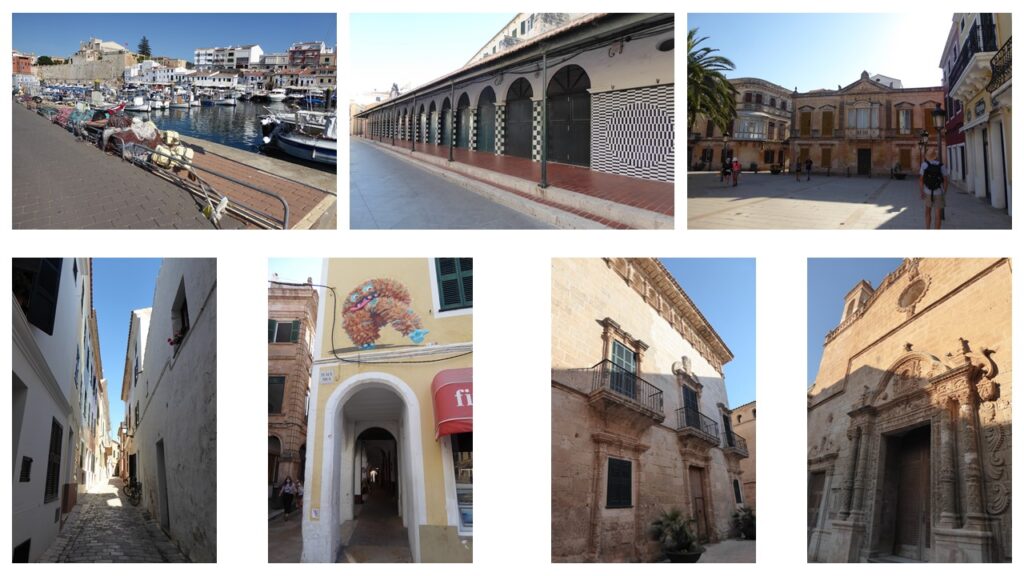
The ancient fortress guards the port; The market; Placa d’Alfons III
Shady narrow street; Ses Voltes and street art; Can Saura; Esglesia del Roser
Overlooking the port below, the Ajuntament or Town Hall stands on the site of the old Muslim fortress, from which the town was guarded and trade controlled. It was the palace of the Arab governor, and later of the British until they made Mahón the capital in 1722.
All around the town we saw souvenirs of Sant Joan, a white cross on a burgundy background. It turns out that, as usual, we weren’t there at the right time, for this is the Fiesta de Saint Joan – the festival dedicated to St John the Baptist, the patron saint of Menorca, celebrated around 24 June. Research suggests this is a marvellous spectacle, rooted in religious history, now developed into parades, processions and parties. Cavallers dressed all in white, including bow tie, with black tail coat and riding hat, ride the indigenous black horses of Menorca through the streets of the city, making them stand on their hind legs in bots. The saddle is intricately decorated, and the saddlecloth sumptuously embroidered. Noble families host grand parties, and a ram, symbolising Christ the Lamb of God, is carefully washed and groomed and carried through the streets within the parade.
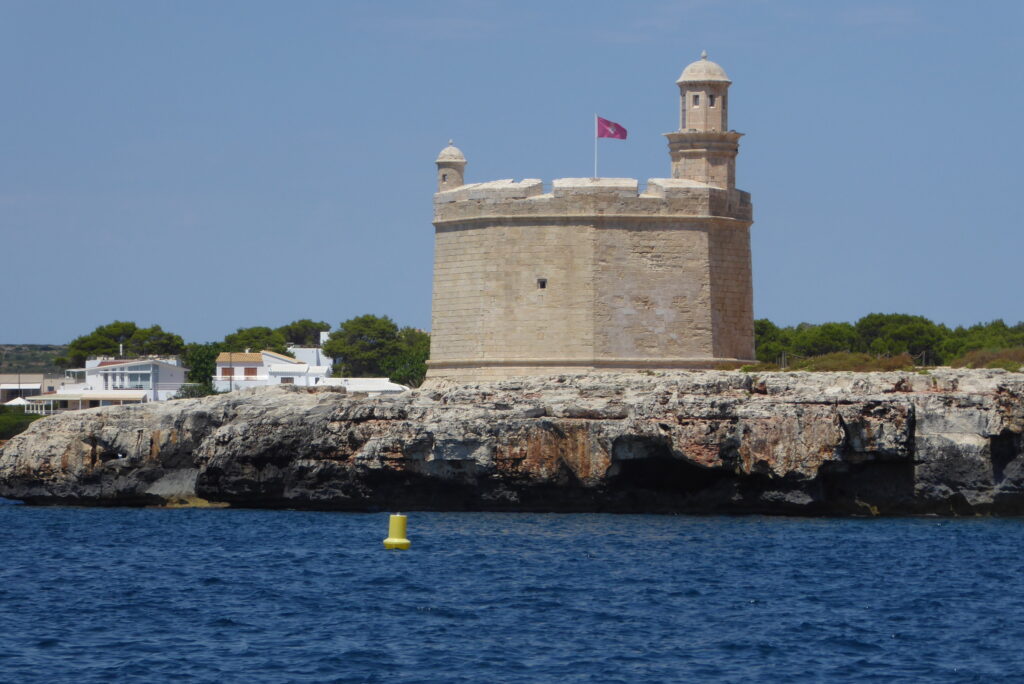
As we made our way back down to the port, the evening paseo was beginning as people began to emerge for the evening stroll by craft market stalls and ice cream parlours. Down on the quayside, buildings emerge from the cliff face, once boat houses and now a selection of bars and restaurants. At the mouth of the harbour we swung around the attractive Castell de Sant Nicolau, the watchtower built in an octagonal shape by Spain in the late 18th Century as a first defence of the city from attacks by sea.
The final act of our entertainment programme for the day was provided by a large, elegant motor yacht, who attempted to return to “his” home berth on Sunday evening, anchoring less than twenty metres from us when he was 25 metres long. It doesn’t require an Einstein brain to realise that, unless we all turn at exactly the same pace in any wind changes, a collision is more than likely. However, the French master (of a UK-flagged boat) was unwilling to find a safer spot, and Skipper resorted to calling the Coastguard for advice and to log the incident in case it should result in insurance claims. Judicious placing of fenders and a close watch avoided any untoward intimacy overnight, but it could not have been considered restful.
On Monday we repeated the dinghy ride into the heart of the old city, but were disappointed to find only a fraction of the market open this morning, and the fish hall not at all. We resigned ourselves to some very expensive vegetables from a delicatessen, where Skipper also chose some excellent jamon iberico (cured ham), whilst some fresh meat items and a piece of local cheese were purchased from the market stalls that were open for trade.
In 34˚C inside at 1600, we set off for an anchorage somewhere on the North coast, enjoying a lovely genoa run in a light Southerly F2-3. We were bemused to see many structures among the fields along the skyline, of the same shape and size, and apparently built of large evenly shaped rocks – were they pig pens? Shepherd shelters? Giant beehives? As ever, the ubiquitous Internet came to the rescue where the guide book had failed for lack of photos with the description – they are ancient burial chambers known as navetas. Nave means ‘boat’ in Spanish, and the structures look like overturned hulls. This type of tomb is unique to Menorca, and dates from the 9th Century BC. They were built using the Cyclopean technique, where medium sized stones were fitted together as a dry stone wall. Inside there are two levels, separated by stone slabs. Archaeological excavations have revealed that large numbers of bodies were laid to rest within the tombs, accompanied by bracelets and weapons in bronze, bone buttons and pottery items. This is but one example of a range of evidence across the island of human habitation since prehistoric times.
Just before sunset we were happily settled – in Cala S’Escala – with only one neighbour, another aluminium yacht with a sunny yellow livery and a hammock swinging above the foredeck. The rock fringe of the bay was spectacular, and it was perfectly peaceful.
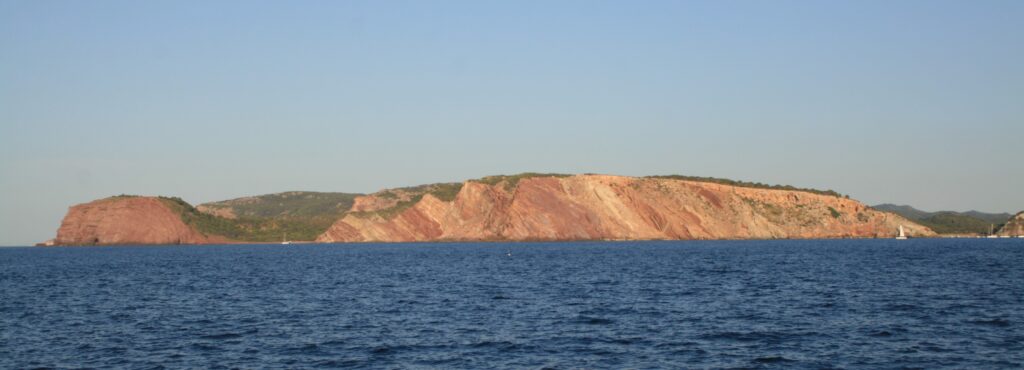
Tuesday was another quiet day at anchor, languishing in the relentless heat – even the sea feels like bathwater, so a dip is not now so refreshing.
